Headlines and events archive
Displaying 1101 - 1150 of 1931
You may also find an archive of news published in the media which are related with the Instituto de Astrofísica de Andalucía - CSIC.
Pages
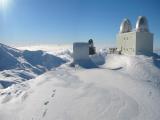
|
14/02/2012
Advances for the protection of the sky at Andalusian observatories The Ministry for the Environment of the Regional Government of Andalusia has just established the influence area of Sierra Nevada and Calar Alto Observatories |

|
09/02/2012 - 16:00
Supernovas. Dónde, cuándo y por qué Las explosiones de supernova se encuentran entre los fenómenos más violentos del Universo y la enorme energía que se libera en ellas hace que podamos observarlas a grandes distancias. Estudiando el lugar y la velocidad a la que se producen, podemos obtener información física fundamental de las galaxias en las que ocurren. En concreto, veremos cómo la distribución radial de supernovas a lo largo... Rubén Herrero Illana Sala de Juntas del Instituto de Astrofísica de Andalucía (IAA-CSIC) |

|
02/02/2012 - 13:00
Efectos de los cúmulos ionizantes de baja masa en el espectro de regiones HII y galaxias En este seminario presentaré mi trabajo de tesis sobre el modelado del espectro de líneas de emisión de regiones H II y galaxias con formación estelar. Primero hablaré sobre la influencia de los efectos de muestreo de la función inicial de masas estelares (IMF) en el continuo ionizante de los cúmulos y en el espectro de regiones H II, centrando la atención en los cú... Marcos Villaverde |

|
26/01/2012 - 13:00
Maser emission in evolved stars: from AGB to PNe I will present a review of maser emission in evolved stars from the asymptotic giant branch (AGB) to planetary nebulae (PNe). The circumstellar envelopes of oxygen-rich evolved stars provide optimal conditions to pump different species of masers, emitting at radio wavelengths. Interferometric observations of masers are a powerful tool to study with the highest angular resolution the molecular gas around evolved stars, because... Lucero Uscanga Aguilera |

|
19/01/2012 - 13:00
Dwarf galaxies as dark matter laboratories Dwarf spheroidal galaxies are key objects in the current cosmological paradigm: first, they are the least luminous galaxies, likely signaling the minimum halo mass at which gas can be accreted and converted into stars. Second, they all have ancient stellar populations, providing clues on star formation/feedback processes at early stages of the Universe. Third, they are the most numerous satellites about the Milky Way and M31,... Jorge Peñarrubia |

|
17/01/2012 - 13:30
Albedo and atmospheric constraints of dwarf planet Makemake from a stellar occultation Makemake is an icy dwarf planet with a spectrum similar to Eris and Pluto, and is currently at a distance to the Sun intermediate between the two. Although Makemake’s size (1,420 ± 60 km) and albedo are roughly known, there has been no constraint on its density and there were expectations that it could have a Pluto-like atmosphere. Here we report the results from a stellar occultation by Makemake on 2011... José Luis Ortiz |

|
12/01/2012 - 13:00
Everything you always wanted to know about extinction but were afraid to ask Twenty two years ago Cardelli et al. published their seminal paper on Galactic extinction laws. In the first part of my talk I will explore that (often quoted but also often misunderstood) paper and detail its strengths and weaknesses. In the second part I will describe the two datasets that have finally allowed the Cardelli et al. laws to be tested to their limit and I will present a new family of extinction laws derived from the new data... Jesús Maíz Apellániz |

|
11/01/2012 - 16:00
Profundidad de falla y flujo térmico en Mercurio Los escarpes lobulados son las estructuras tectónicas más relevantes existentes en Mercurio. Su morfología y la deformación producida en su intersección con otras estructuras indican que los escarpes constituyen la expresión en superficie de fallas inversas formadas, principalmente, por el enfriamiento y contracción del planeta. A partir de la geometría de estas fallas podemos obtener... Mª Isabel Egea González Sala de Juntas del Instituto de Astrofísica de Andalucía (IAA-CSIC) |

|
10/01/2012 - 13:30
IAA: its structure, failures, and potential In this talk I will first show the structure of our Institute, the task division and the people responsible for these taks. I will also analyse all the procedures, customs and usages that drift us apart from the dream IAA. Finally, I will make some remarks about the (underestimated? disregarded?) potential of our Institute. Matilde Fernández Hernández |

|
22/12/2011 - 12:34
Dynamical Modeling of Luminous Infrared Galaxy Mergers It is widely accepted that galaxy mergers can have a significant effect on galaxy properties and may be an important part of galaxy evolution. Enhanced star formation is one frequently observed property of (gas rich) mergers and theoretical prescriptions for star formation can generally reproduce the observed behavior. However a detailed study comparison of these prescriptions with individual galaxy merger events has not been... George C. Privon |
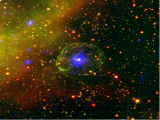
|
18/12/2011
A pulsar too slow for its age It is one of the slowest pulsars known, and its slowness seems incompatible with its age |

|
15/12/2011 - 13:00
X-ray properties of nearby luminous infrared galaxies I present results of X-ray observations of a complete sample of luminous infrared galaxies (LIRGs) from the GOALS, a multi-wavelength project to study the most luminous IR-selected galaxies in the local Universe. X-ray imaging at an arc-second resolution obtained with the Chandra X-ray Observatory provides locations of an active nucleus, if present, and extended morphology of starburst-driven winds in those LIRGs. An inspection of their X-ray... Kazushi Iwasawa |
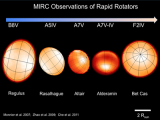
|
13/12/2011
Solved the problem of measuring the temperature of the flattened stars To measure the temperature of the flattened stars is used a theorem that it has now been shown that it is incomplete |

|
01/12/2011 - 13:00
Mass, metallicity and SFR relationships in star forming galaxies using deep surveys To understand the formation and evolution of galaxies, it is important to have a full comprehension of the role played by Metallicity, Star Formation Rate (SFR), and stellar mass of galaxies. The interplay of these parameters at different redshifts will substantially affect the evolution of galaxies and, as a consequence, the evolution of these parameters provides important constraints for the galaxy evolution models. We studied the... Maritza A. Lara-Lopez |
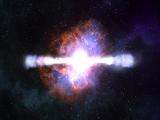
|
01/12/2011
Stars have found a new way to die A peculiar burst detected on Christmas Day 2010 points to the merger of two stars, a neutron star and an evolved red giant, after going through a common-envelope stage. |

|
24/11/2011 - 13:00
The Bayesian Galaxy Cluster Finder and its Application to Large Surveys One of the main purposes of Large Surveys is the study of galaxy clusters. However, it is not an easy task to compile a complete sample. In this talk, I will present a new technique for detecting galaxy clusters called the Bayesian Cluster Finder (BCF) which is able to determine the position, redshift and richness of clusters in any survey. I will introduce the simulations that we performed to test the algorithm through realistic mock galaxy... Begoña Ascaso |

|
23/11/2011 - 16:00
Vientos Estelares en Estrellas Masivas En esta charla se dará una perspectiva general sobre los vientos en estrellas masivas. En particular se pretende explicar la emisión de rayos X alrededor de estrellas masivas evolucionadas. Jesús Alberto Toalá Sala de Juntas del Instituto de Astrofísica de Andalucía (IAA-CSIC) |

|
17/11/2011 - 13:00
Revealing the hidden supernova population in luminous infrared galaxies A substantial fraction of star formation (SF) and hence of the core-collapse supernovae (CCSNe) in the Universe is hidden behind dust. At higher-z obscured star formation in luminous and ultraluminous infrared galaxies (LIRGs and ULIRGs) actually dominates over SF seen in the UV and optical. These same objects are expected to hide in their nuclear regions large numbers of undetected CCSNe. In this talk I describe our ongoing efforts using... Seppo Mattila |

|
13/11/2011
Found the key to complete the models of the "sprites" in the upper atmosphere IAA scientists have found the reason why sometimes these flashes occur with some delay with respect to the lightning that triggers |

|
07/11/2011
Science Week at IAA Fifht edition of Noches de Ciencia, a series of conferences for the Science Week |

|
03/11/2011 - 13:00
Gamma-Ray-Bursts, High-Energy-Cosmic-Rays and Beam-Plasma Instabilities Gamma-Ray-Bursts and High-Energy-Cosmic-Rays are two of the most intriguing enigmas of astrophysics. A promising scenario solving both problems consists in the Fermi-like acceleration of particles by relativistic collisionless shocks. These shocks could generate the Gamma Burst together with some highly energetic cosmic rays, in the earlier phase of a Supernovae explosion. Later on, the Supernovae Remnant could still accelerate cosmic... Antoine Bret |

|
02/11/2011 - 16:00
El zoológico de los plasmas en la alta atmósfera En verano de 1989 investigadores estadounidenses grabaron varios fotogramas de intensos destellos luminosos provenientes de un fragmento de cielo, sin nubes localizado a más de 50 km de altura y que, sin que ellos se dieran cuenta en ese momento, se encontraban sobre lejanas nubes de tormenta. Habían hecho la primera observación de los llamados Transient Luminous Events o TLEs. Francisco Carlos Parra Rojas Sala de Juntas del Instituto de Astrofísica de Andalucía (IAA-CSIC) |

|
27/10/2011 - 14:00
Locating the gamma-ray emission region in AGN from multi-messenger observations Relativistic jets in AGN, in general, and in blazars, in particular, are among the most energetic and powerful astrophysical phenomena known so far. Their relativistic nature provides them with the ability to emit profusely at all spectral ranges from radio wavelengths to gamma-rays. They display extreme variability at all time scales (from hours to years). Since the birth of gamma-ray astronomy, locating the origin of gamma-ray emission has... Iván Agudo |
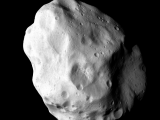
|
27/10/2011
Lutetia gives clues about the origin of the Solar System The asteroid pictures come from Rosetta show that it is a primitive Solar System Object |
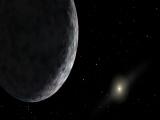
|
26/10/2011
The dwarf planet Eris could be smaller than Pluto It has used the occultation of a star by Eris to determine its size accurately |

|
20/10/2011 - 14:00
Mapping star-formation in the Milky Way In the last few years, it has become possible to measure the distance and the velocity vector of young stars located within 500 pc of the Sun with an accuracy of order 1% using Very Long Baseline Interferometry (VLBI) techniques. This represents an improvement by more than 1 order of magnitude over what was previously possible, and opens the door to some extremely high accuracy astrophysics. In particular, theoretical pre-main sequence... Laurent Loinard |

|
06/10/2011 - 15:00
Estallidos de rayos gamma: una breve introducción Los Estallidos de Rayos Gamma son los eventos más energéticos en el Universo después del Big Bang. Ocurren a distancias cosmológicas, con desplazamientos al rojo conocidos de hasta z=8.2. Son fenómenos de sumo interés para diversas áreas de la Astronomía y la Física de Altas Energías. Dada la falta de transparencia de nuestra atmósfera a los rayos gamma y la corta... Juan Carlos Tello Sala de Juntas del Instituto de Astrofísica de Andalucía (IAA-CSIC) |

|
22/09/2011 - 14:00
Early r-process enrichment in the halo: Process and implications/The future role of the Nordic Optical Telescope I: Early r-process enrichment in the halo: Process and implications Current thinking suggests that the outer Galactic halo formed first, with stars dominated by fresh C(NO) elements, but soon with increasing amounts of heavier elements. The now appreciable sample of extremely metal-poor (EMP) stars with [Fe/H] ~ -3 trace the transition to this chemically more diversified regime. A small fraction of these EMP giants contain r-process... Johannes Andersen |
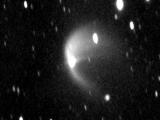
|
21/09/2011
The tail of the Scheila asteroid was due to a probable collision event In 2010, the Scheila asteroid showed like a comet, with a well defined tail that disappeared in a few days. IAA astronomers analyzed the event and attributed to a probable collision event |

|
16/09/2011 - 13:00
Early Planet Formation from an Experimentalist’s Point of View Planet formation starts in gaseous protoplanetary disks. Small grains move around, collide, stick together and grow. However, many collisional roads also lead to destruction of larger bodies. Which ones are prevailing and if this is the basic way to planet formation is still an open question, but there are modes to grow particles to larger size even in ‘high speed’ collisions. This talk will also touch upon processes of transport... Prof. Gerhard Wurm |

|
05/09/2011 - 09/09/2011
20th Stellar Pulsation Conference Series Granada |

|
07/07/2011 - 14:00
Coagulation, restructuring and fragmentation of dust grains in the protoplanetary disks: first stages of Solar System formation The understanding of the formation of the planetary systems is one of the main topics of modern astrophysics and its study requires a synergetic effort of observations, laboratory experiments and theoretical models. It is generally accepted that planets originate in the dust disk that remains around a star after its formation (protoplanetary disk). Nevertheless there are no clear ideas on the physical conditions that are required, neither on... Walter Sabolo |

|
30/06/2011 - 14:00
Quasi-periodicities in the periodograms of Corot Delta Scuti stars Periodic patterns are not expected to be found in the frequency spectra of delta-Scuti stars, as in solar-like pulsators. However, some efforts have been carried out in order to find any signal of periodicity in this type of stars (Handler et al., 1997; Breger et al., 1999, 2009). These works used ground-base observations and the results have not been conclusive. In our study we have used data from CoRoT of two delta-Scuti stars poorly known. We... Antonio García Hernández |

|
29/06/2011 - 15:00
El impacto de la astrosismología en astrofísica El conocimiento sobre la estructura y la física de los interiores estelares ha tenido un importante avance durante las últimas décadas gracias a la interpretación de las pulsaciones observadas en ellas. Esa es la meta principal de la Astrosismología. No obstante, los resultados que se desprenden de las investigaciones realizadas por astrosismólogos pueden tener un gran impacto sobre distintos campos de... Javier Pascual Granado Sala de Juntas del Instituto de Astrofísica de Andalucía (IAA-CSIC) |

|
20/06/2011 - 14:00
Simulation of Relativistic Jets with Macroscopic and Microscopic Processes and Associated Self-consistent Radiation Relativistic jets are ubiquitous in astrophysical systems. In this talk I will present recent research results from RMHD simulations designed to study the CD kink instability of relativistic jets and the magnetic field amplification that occurs in relativistic shocks in an inhomogeneous medium. I will then present the results of RPIC simulations of particle acceleration in relativistic shocks and self-consistent calculation of the radiation at... Ken Nishikawa |

|
16/06/2011 - 14:00
Time-Dependent Hamiltonians in Quantum Mechanics and Inflationary Cosmology We revise the problem which appears in Quantum Mechanics when the Hamiltonian depends explicitly on time and provide a general setting to address such quantum systems. As a paradigmatic example we analyse the case of the damped harmonic oscillator (satisfying the Caldirola-Kanai equation) and extend the system to accomodate the ordinary time translation as a true symmetry (Bateman dual system). This general scheme applies in particular to the... Julio Guerrero García |

|
08/06/2011 - 15:00
Método K-Correlated para el estudio del transporte radiativo en Marte En esta sesión CCD os explicaré en que consiste el método k-correlated, técnica usada para el estudio del transporte radiativo. Hablaré sobre sus ventajas e inconvenientes y expondré algunos de los últimos resultados que hemos obtenido. Javier Ruiz Madrona Sala de Juntas del Instituto de Astrofísica de Andalucía (IAA-CSIC) |

|
07/06/2011 - 14:00
EST: a large solar telescope for the XXI century The European Solar Telescope (EST) is a project for a 4-meter class telescope to be located in the Canary Islands. It is promoted by the European Association for Solar Telescopes (EAST). This is a consortium formed by a number of research organizations from fifteen European countries (Austria, Croatia, Czech Republic, France, Germany, Hungary, Italy, the Netherlands, Norway, Poland, Slovak Republic, Spain, Sweden, Switzerland, and United... Manolo Collados |

|
07/06/2011 - 09/06/2011
III Reunión Española de Física Solar y Heliosférica Granada |

|
05/06/2011 - 10/06/2011
II Workshop on Robotic Autonomous Observatories Málaga |

|
02/06/2011 - 14:00
Coronal heating on the Sun: new observations and “realistic” 3D numerical models The heating of the solar corona is a long standing problem of solar physics, in fact dating back to the time when it was first discovered that the corona was quite hot. In short, the question is how one can find a credible physical mechanism to transport and dissipate a small fraction of the “mechanical” energy contained in the convection zone in(to) the corona. Amusingly, most answers to the question date back to the late 1940... Prof. Viggo Hansteen |

|
31/05/2011 - 14:00
Dark Matter and Stars Under the assumption that Dark Matter (DM) is composed of Weakly Interacting Massive Particles (WIMPs), it can affect the properties of stars. In the local Universe effects are feeble, nonetheless they can in principle be used in order to pose constraints on the nature of DM particles with observations of the Sun, and of compact objects at the Galactic Center, in Globular Clusters and in White Dwarf Galaxies. The first generation of stars to... Fabio Iocco |

|
26/05/2011 - 14:00
The BigBOSS dark energy experiment The BigBOSS experiment is a project designed to unlock the mystery of dark energy using existing ground-based facilities operated by National Optical Astronomy Observatory (NOAO). A new 5000-fiber R=5000 spectrograph covering a 3-degree diameter field will measure clustering properties in the distribution of galaxies and hydrogen gas spanning redshifts from 0.2 < z <3.5. This project will enable an unprecedent multi-object spectroscopic... F. Prada & M. Azzaro |

|
23/05/2011 - 27/05/2011
Stellar Clusters & Associations: A RIA Workshop on Gaia Granada |

|
12/05/2011 - 14:00
ALMA Early Science Tbd Stéphane Léon |

|
09/05/2011 - 11/05/2011
3rd High Energy Particles Precipitation in the Atmosphere Workshop Granada |

|
05/05/2011 - 14:00
Gamma-ray Bursts - what kind of stars do they come from? Long GRBs are the most luminous objects in the universe and mark the collapse of a very massive star, usually accompanied by a relativistic supernova. Their large distances do not allow us to directly identify the progenitor star as we were able to do with some type of supernova. We therefore rely on indirect methods to derive some information on the kind of progenitor star or system and what makes a massive star to explode in a supernova or... Christina Thoene |

|
28/04/2011 - 14:00
The connection between missing stellar cusps in galactic nuclei and general relativity One of the most interesting sources of gravitational waves is the inspiral of compact objects on to a massive black hole (MBH), commonly referred to as an extreme-mass ratio inspiral. The small object, typically a stellar black hole, emits significant amounts of GW along each orbit in the detector bandwidth. On the other hand, recent observations of the Galactic center revealed a dearth of giant stars inside the inner parsec relative to the... Pau Amaro Seoane |

|
14/04/2011 - 14:00
Discos de acreción alrededor de protoestrellas de masa alta e intermedia Las observaciones directas, que resuelvan angularmente los discos de acreción en torno a estrellas jóvenes de masa alta e intermedia son escasas. Presentaré los resultados de nuevas observaciones radiointerferométricas de alta resolución angular que, junto con nuestros modelos teóricos, revelan la presencia de discos de acreción en torno a dos estrellas en formación. En el caso de la... Mayra Osorio |

|
24/03/2011 - 13:00
The dirty side of astronomy: carbonaceous dust Since the beginning of modern astronomy, dust has always been considered an obstacle on the path to understanding both nearby and far away phenomena. In this talk I will explain briefly the origin and the life-cycle of carbonaceous dust, introduce to new discoveries and old puzzles and eventually show how dust can be used as a powerful astronomical tool. Alessandra Candian |